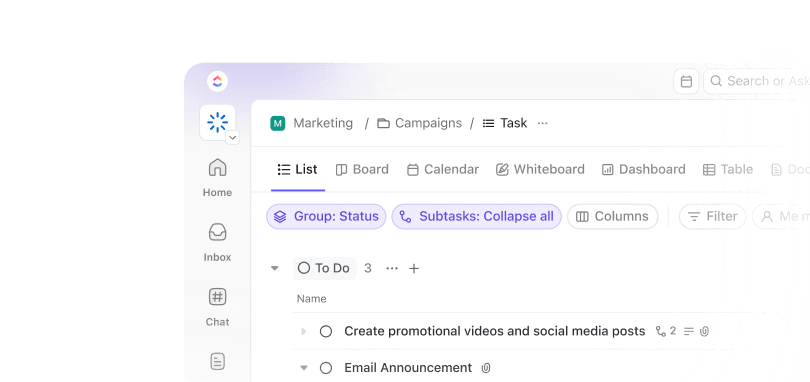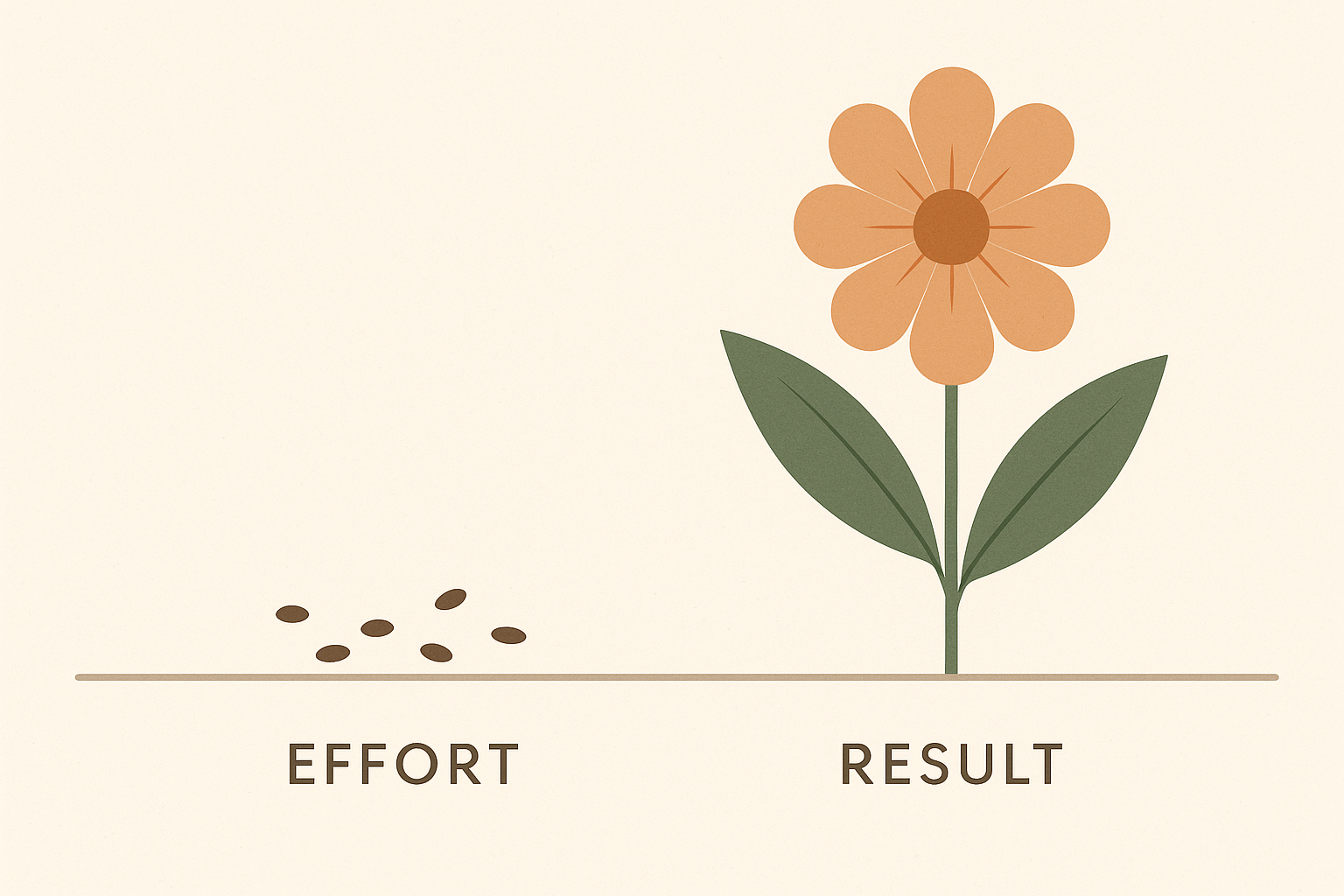It’s a lazy Sunday afternoon.
You’ve just ordered a feast from your favorite restaurant, filled with all your go-to comfort dishes.
Dressed in those perfectly lived-in pajamas, you settle in and cue up that show, the one you know so well you could recite every line in your sleep. Sound familiar?
We gravitate back to the same habit loops, the same shows, the same dishes, not because we’re unimaginative, but because a small fraction of things really do deliver most of the value.
That instinct is the heartbeat of the Pareto Principle, the 80/20 Rule.
First spotted in economics over a century ago, the principle has become one of the most cited heuristics across life: focus on the vital few, ignore the trivial many.
Let’s break it down!
The Pareto Principle: Origin and Definition
Vilfredo Pareto’s discovery keeps showing up uninvited in your life, like a relative at Thanksgiving.
Italian economist Vilfredo Pareto first identified it over a century ago when he observed that 80% of Italy’s land was owned by just 20% of the population. However, what makes it stick is that the pattern didn’t remain confined to economics. It metastasized.
Fast forward to today:
- 20% of customers drive 80% of revenue
- 20% of coding bugs cause 80% of crashes
- 20% of your wardrobe gets worn 80% of the time
And your Spotify Wrapped? Probably five songs on infinite repeat.
The numbers aren’t gospel, mind you; sometimes it’s 70/30, 90/10, or even more lopsided, but the imbalance shows up so reliably that it’s become one of the most cited heuristics in business and productivity. This is where things tend to get dangerous.
The 80/20 rule simply describes reality. As the word ‘heuristic’ suggests, it is something to be aware of and loosely followed.
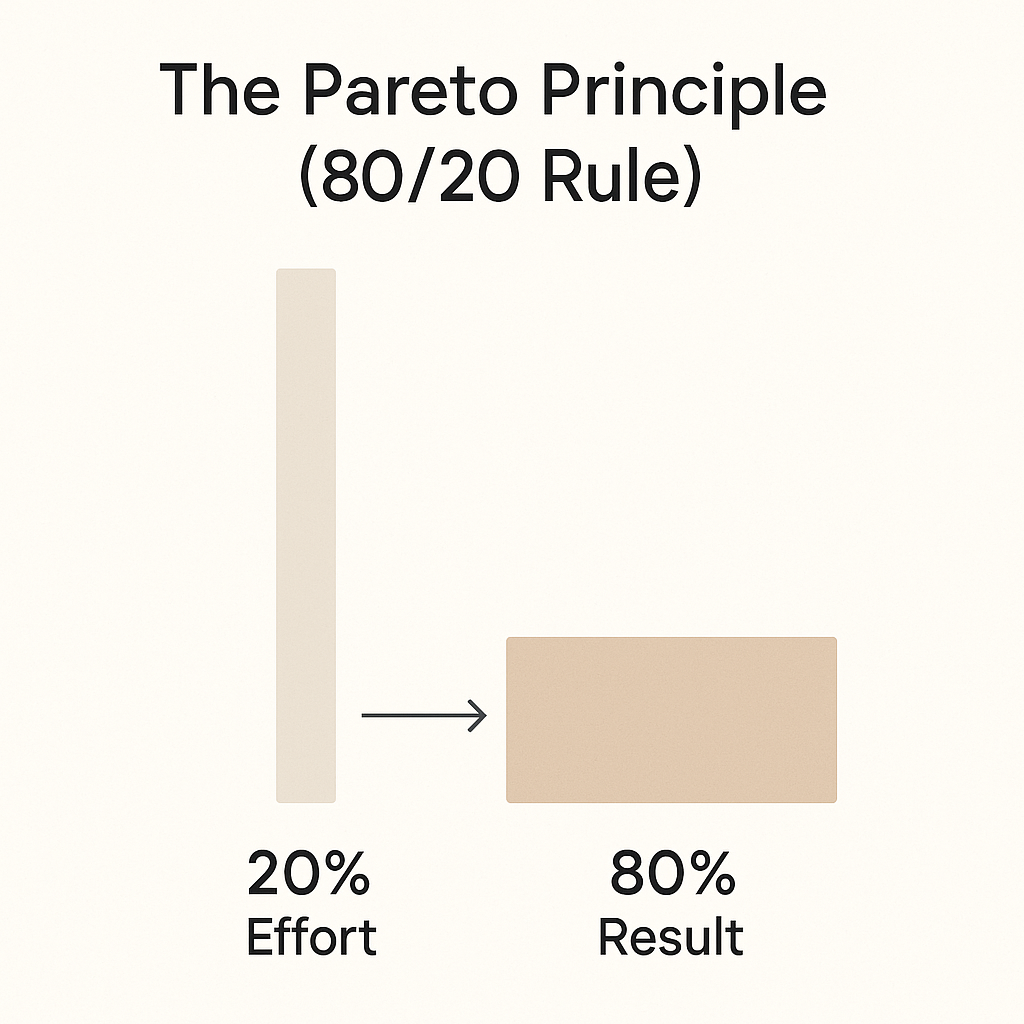
What Problem Does the 80/20 Rule Solve?
Most of us tackle work like overeager optimists.
Eyeing that gold star on our report card, even as adults. But slogging away hours with hundreds of cups of coffee is not the way to do it.
The classic effort vs. impact dilemma
We assume that doubling our effort should double our results. Unfortunately, psychology says otherwise.
Humans are notoriously bad at estimating the relationship between input and output. We conflate busyness with effectiveness (Hsee et al., 2010), and burnout feels like it should be congruent with professional achievement, but it isn’t.
Endless low-impact tasks keep us “productive” but not progressing. The Pareto Principle slices through that illusion. It reframes the problem of limited time and energy by asking: Which small set of actions will have the most significant impact?
But here’s the trap: once you turn 80/20 into a religion, or worse, a KPI, it stops being a lens and starts being a liability.
What if effort is not the end goal, but the path itself?
Goodhart’s Law warns that when a measure becomes a target, it ceases to be a good measure.
You decide to spend “quality time” with your kids. A few hours each evening, phones away, playing or talking. It feels great. Everyone’s closer and happier.
Then you read somewhere that “good parents spend at least two hours of quality time with their kids daily.” So you make that your rule.
Soon, it turns into a box you have to check: you watch the clock, make forced conversation, and stress when life gets busy and you fall short.
The time is still there, but the warmth and connection that made it quality in the first place? Gone.
One more example, take quality control in manufacturing: Juran (1954), who popularized Pareto’s work, found that a handful of defect types accounted for the vast majority of quality issues. Instead of spreading resources across every minor glitch, companies targeted those few major causes and slashed error rates dramatically.
It’s trivial details vs. your attention every day
Decision fatigue research shows that every choice we make chips away at mental energy (Baumeister et al., 1998).
When your day is clogged with trivial decisions, checking every email, attending every “sync”, you’re burning precious bandwidth on the “trivial many” instead of reserving it for high-impact work.
In other words, the Pareto Principle solves the problem of misallocated attention.
It gives you permission, and, frankly, a mandate, to ignore most things so you can focus on the few that count.
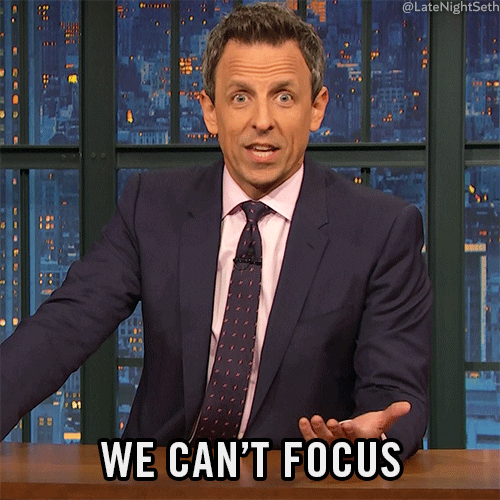
Time management and the Pareto principle
Managing your time well basically comes down to focusing on the stuff that really moves the needle. Let’s do it the Pareto style!
One way to do that is by budgeting your time so you actually know where your day’s going instead of letting it slip away. Another trick is time blocking or blocking off chunks of time to focus on one thing without distractions.
Starting your morning off right can also make a big difference, and there’s a great guide on how to have a productive day that can help with that.
But hey, sometimes we just lose track of time. All these little time management hacks work together to help you allocate your energy to what really matters.
Why the 80/20 Rule Works as a Decision-Making Tool
You know that feeling when data confirms what you already suspected?
Your fitness tracker tells you, “You slept poorly.” – Well, yeah, Sherlock!
That’s the 80/20 rule, math backing up what your brain kind of already figured out or can see readily.
The math never lies
At its heart, Pareto is what statisticians call a power-law distribution: outcomes are rarely spread evenly. Instead, a few factors dominate results (Newman, 2005).
That’s why a handful of startups generate most of the venture returns. And why 4% of stocks created all net wealth in U.S. markets between 1926 and 2016 (Bessembinder, 2018).
Now add the psychology. We’re wired with a “more is better” bias, as mentioned earlier.
Put in more hours, attend more meetings, answer more emails, and surely results will follow. Except they don’t. Behavioral scientists call this the “effort heuristic” – we mistake sweat for value (Kruger et al., 2004).
The 80/20 rule demolishes this assumption. Strategic focus beats sheer volume, every time.
Your brain has a bandwidth problem
Working memory is brutally limited, and your house keys are often the biggest victims.
Most people can juggle only 4–7 items at once (Cowan, 2001). Scatter your attention across dozens of tasks and quality craters.
Zero in on the “vital few,” and you’re working with your brain’s architecture, not against it. The same goes for the decision-making process. The buffet of choices we have for everything from dinner options to entertainment paralyzes us (Schwartz, 2004), but the 80/20 lens cuts through the noise.
Reality is skewed. Our brains are limited. The 80/20 rule doesn’t fight either one; it weaponizes both.
Practical Applications of the Pareto Principle
Right, enough theory.
Pareto has been spotted in the wild. Let’s observe it in its natural habitat.
Productivity: The Bezos pivot
Bill Gates once quipped, “I choose a lazy person to do a hard job. Because a lazy person will find an easy way to do it.” The Pareto Principle is that quip with a balance sheet.
Take Jeff Bezos in 1994. He was pulling a six-figure salary at a hedge fund, the kind of job people don’t leave.
But Bezos had a framework he called “regret minimization”, a thought experiment where he imagined himself at 80, looking back. Would he regret leaving Wall Street to start an online bookstore? Maybe. Would he regret not trying? Definitely.
That’s Pareto thinking in disguise.
Bezos wasn’t weighing every possible decision equally. He isolated the 20% of choices that would define his life’s trajectory and let the rest fall away. The result? Amazon. And yes, a few regret-free decades.
The lesson isn’t “quit your job and start Amazon.”
It’s that most of what clogs your to-do list doesn’t help you move forward. Clear those out, and the mental relief compounds faster than the guilt.
Business: Starbucks and the whale strategy
Growth teams love to talk about “customer acquisition.” But here’s what Starbucks figured out: acquisition is expensive, and most customers are … fine. Not great, not terrible. Just fine.
In the early 2010s, Starbucks analyzed purchase behavior and discovered a lopsided truth: roughly 20% of customers accounted for nearly half of revenue (Starbucks Annual Report, 2016). These weren’t casual visitors grabbing a latte twice a month. They were the daily regulars, the mobile-order addicts, the people who knew baristas by name.
So instead of chasing every passerby with discounts, Starbucks doubled down on the whales.
The result was Starbucks Rewards, a loyalty program that now has over 75 million active members and drives more than half of U.S. company-operated revenue. Keep the high-value customers caffeinated, personalized, and locked in, and revenue volatility smooths out.
The broader lesson? Growth often doesn’t come from chasing everyone. It comes from obsessing over the few who already pay your bills, and making sure they never leave!
📖 Read More: Eat the Frog Technique: Go From Dreading to Doing!
Education: High-yield medicine and the art of strategic ignorance
Growing up, my standard answer to “What do you want to be when you grow up?” was always “doctor.”
Then I saw the syllabus. Thousands of pages. Hundreds of conditions. Latin names that sounded like spells. I gave up promptly.
Turns out, I was doing it wrong. Medical students don’t memorize everything either. They just memorize the right things.
“High-yield” study guides, resources like First Aid for the USMLE, which distill around 20% of material that shows up on 80% of licensing exams. Medical students drill conditions like myocardial infarction, diabetes, and pneumonia, common, high-stakes, testable, while skimming rare zebra diagnoses that might appear once in a career.
The smart student studies less, better, and frees up mental bandwidth for the clinical judgment that no textbook can teach.
Research backs this up. Spaced repetition studies (Cepeda et al., 2006) show that strategically re-reviewing key concepts delivers far greater retention than flat cramming.

Journaling hacks to work smarter, not harder
Some of us need a bullet list of priorities before we even start with Pareto and other amazing hacks. How about some bullet journaling then? Combining your writing with digital journaling apps lets you capture ideas instantly and organize them without flipping through pages.
If you love sticky notes but hate the clutter, online sticky notes bring the best of both worlds right to your screen. And for those who enjoy classic pen-and-paper, simple hacks from these bullet journaling basics can boost creativity while keeping your layouts clean and effective.
Personal life: The friendship funnel
Sociologists McPherson et al. (2006) found that most people’s social networks collapse down to a tiny handful of confidants—about two or three, not twenty.
I realized this when I spent 20 minutes agonizing over whether to attend a former coworker’s birthday dinner. Someone I hadn’t talked to in a year. The guilt was real, until I calculated: two hours of commute and small talk, or one call with my best friend who actually needed to vent about her breakup.
That’s Pareto in your social life.
The energy you’d spend maintaining weak-tie friendships, liking Instagram posts, and attending birthday dinners for acquaintances can go toward the few relationships that actually sustain you. Once you embrace the skew, you stop spreading yourself thin.
And the people who matter? They get the best version of you, not the exhausted one.
How to Apply the 80/20 Rule
Meet Maya, a doctoral student struggling with busywork.
It’s 10 a.m. and Maya has already cleaned her inbox twice, and pored over citations somebody recommended last week. Her actual deliverable? The thesis hasn’t moved an inch.
Here’s how Maya stopped spinning and started moving using the 80:20 rule.
Step 1: Define the outcome (or admit you don’t have one)
Maya’s first realization was uncomfortable: she had no idea what “done” actually looked like. Was the goal to “read every book ever,” or to focus on her own hypothesis? One of those is a feeling; the other is a result. Without that clarity, everything feels equally urgent, and nothing really matters.
She wrote it down: Get one chapter done by Friday. Read only what would support this goal.
Suddenly, half her to-do list looked irrelevant.
Step 2: Track the truth (because your gut is lying)
Maya assumed reading took “maybe 3 hours a day.”
So she logged her time for a week, using a simple time tracker, and discovered the brutal truth: 40% of her day disappeared into skimming newer studies or findings that are great but not relevant to her work.
This isn’t unusual. Studies show we underreport distractions by nearly half (Mark et al., 2016). We lie to ourselves about where the hours go, and without data, the lie wins.
Step 3: Find your vital 20% (the X-ray vision moment)
With her time logged and her outcome clear, Maya could finally see the imbalance.
Two specific studies could completely support her thesis, yet she’d been splitting her focus evenly across ten.
The write-up she was building? It mattered. But getting pulled into every new study? That didn’t.

Step 4: Kill projects, or they’ll kill you
Here’s the part most people miss: someone has to be the assassin.
Maya appointed herself as the official “project killer” for a day. You know, the person responsible for shutting down commitments that no longer aligned with her goals. It sounds dramatic, but without that explicit role, dead ideas linger forever, draining resources and morale like a slow leak.
And here’s the kicker: the vital 20% isn’t static. What mattered last semester might be clutter now. Maya set a recurring review for every semester, a forcing function to reassess priorities before they calcified into dead weight.
Step 5: Reassess (because the game changes)
Your needs evolve. What was high-impact yesterday may fade tomorrow. But Maya’s semester check-ins help ask the question: Which tasks deserve our best energy right now?
Not “What are we working on?” but “What should we be working on?” The difference is everything.
And for the first time in months, she worked without that nagging feeling that she’d forgotten something critical, because she knew exactly what mattered, and it was done.
The 80/20 Workflow: An Example With ClickUp
The Pareto lens shows you where to focus.
Here’s how to operationalize Maya’s approach, not as theory, but as a workflow.
First: You can’t act on the vital few if you don’t know what they are
Most people think they know their priorities. They’re usually wrong.
The first step is to get everything visible in one place,a spreadsheet and planner, or your tool of preference, so you can actually see the imbalance.
Now comes the reality check: turn on Time Tracking to see how much effort you’re actually spending versus what you thought you were spending.
Remember Maya? She thought reading took 3 hours a day. It took 60% of her week. This was her list:
| Task | Description | Notes |
|---|---|---|
| Read journal articles on British colonization | Background reading | May overlap with other sources |
| Could support the comparison section | Key economic data | Might provide strong primary evidence |
| Review Spanish colonial policies | Historical overview | Possibly for an appendix or presentation |
| Gather data on the Atlantic slave trade | Sets up thesis focus | Can be refined later |
| Collect maps of 18th-century trade routes | Visual reference | Read secondary sources on the East India Company |
| Analyze triangular trade impacts | Connects trade and colonization | High analytical value |
| Research French mercantile policies | Part of comparative analysis | Medium depth required |
| Format bibliography | Final-stage task | Time-consuming but low-impact |
| Examine the cultural impacts of trade | Context for global trade | Need to limit scope |
| Draft chapter on economic effects | Core content | Needs strong data and sources |
| Edit footnotes and citations | Technical polishing | Important for accuracy, not argument |
| Adds depth to the argument | Adds depth to the argument | Could be a smaller section |
| Search for primary letters from merchants | Primary evidence | Could offer unique insight |
| Create thesis outline | Planning tool | Helps focus early stages |
| Proofread conclusion | Final check | Not urgent until last stage |
💡 Pro Tip: Start in List View in ClickUp and list everything you are juggling, big or small. Then add a Custom Field called “Impact Score” (rate 1–5) and another for “Category” (strategic, support, ops, etc.). Use historical data or your gut instinct to rate which tasks yield the highest ROI.
Second: You need to know what matters at a glance
Once the vital few are exposed, the challenge is keeping them top-of-mind.
Without a clear visual system, people—Maya included—tend to prioritize what’s loudest, not what’s most important. To stay aligned with her goals, she began assigning Priority Levels to every task: Urgent, High, Normal, or Low.
This helped her instantly see what truly deserved her attention each day.
For example, analyzing trade data and drafting her main argument became a High Priority, while formatting citations and proofreading remained Low until the final stage. By glancing at her task list, Maya could immediately tell where her effort would have the greatest impact.
🛠️ Toolkit: For a visual aid, you can use ClickUp’s Priority Matrix Template, with urgency on one axis and importance on the other. It’s the Eisenhower Matrix, but live and collaborative.
Third: Pareto is useless if it doesn’t ladder up to outcomes
Now you need to connect that vital 20% to measurable goals.
When Maya began working on her thesis about colonization in the early 18th century and the impact of trade, she quickly realized how overwhelming the topic could be.
To keep her work efficient, Maya created a list of all the tasks she needed to complete, including researching sources, organizing data, writing chapters, and editing drafts. Then she ranked each task by its importance and potential impact on her thesis.
Based on this, Maya decided to spend most of her time on the top 20%, focusing on activities that would directly strengthen her argument, such as analyzing trade records, engaging with major historians, and refining her central thesis statement. Here’s the breakdown:
| Thesis stage | The “vital 20%” tasks | The “trivial 80%” tasks |
|---|---|---|
| Topic research | Identify 2–3 major colonial powers (e.g. Britain, France, Spain) and 2–3 key trade systems (e.g. Atlantic slave trade, triangular trade, East India trade) | Reading about every single colony or minor trade network |
| Literature review | Focus on seminal works and primary sources that shaped academic debate | Secondary sources repeating similar arguments |
| Data & evidence | Gather representative trade data (exports, commodities, port records) and key primary accounts | Collecting large but repetitive or minor data sets |
| Analysis | Examine cause-and-effect relationships (e.g., how trade fueled colonization, or vice versa) | Descriptive summaries without analysis |
| Writing | Develop core arguments and thesis statement early | Perfecting minor formatting or excessive background sections |
| Editing | Prioritize clarity, argument strength, and evidence coherence | Over-polishing footnotes or formatting early on |
And there you have it! An actionable to-do list of vital tasks that can truly help you move toward your goals! With ClickUp Tasks + ClickUp Brain, you can easily turn this into a trackable task list like this and start executing.👇🏼
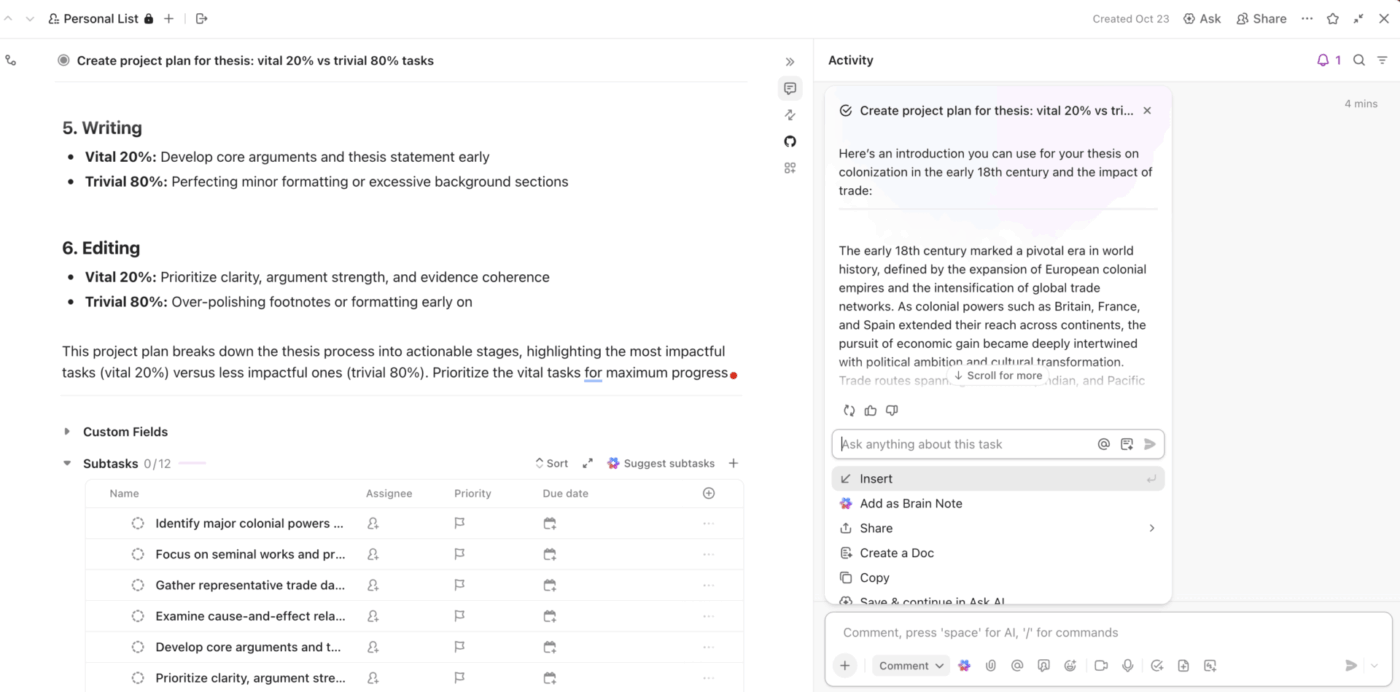
⚡️ Template Archive: Free Project Prioritization Matrix Templates
Industry-Specific Uses of the 80/20 Rule
We already talked about this.
The true power of the 80/20 Rule lies not just in identifying where results come from, but in fundamentally changing how industries think about value and effort.
It challenges the traditional “work harder, do more” mentality by revealing that success often depends on doing less, but better. This mindset shift has ripple effects across various fields, including marketing, manufacturing, healthcare, and technology.
Let’s take a closer look.
Marketing: Stop sprinkling, start spotlighting
Quick anecdote time.
I worked in a start-up and, as it goes, took on any work that came my way. My first big assignment was to build a newsletter for a brand that was a fledgling.
The red flags were obvious; we weren’t dealing with an audience that enjoyed reading, and the topics we wanted to write about were not new, and we didn’t have the expertise to write about them. And yet we went ahead, guns ablazing and how.
Only to realise 6 months (!) later that this time could be better spent on places where we were actually getting users from: our performance ads, our YouTube channel, our Website. A handful of channels were doing all the work. The rest, including our precious newsletter, was just burning budget.
Google’s own benchmarks show the skew is still brutal: typical CTR for Google search ads hovers around ~1.9% (Ignite Visibility, 2025). That means even when your ad is seen thousands of times, only a sliver ever taps. And yet, how many marketers are still sprinkling budget evenly across every campaign like they’re watering a lawn?
Sales: Your top accounts are keeping the lights on
Every sales pipeline looks like a long tail: hundreds of prospects, endless follow-ups, and a CRM that never stops nagging. But most of your revenue is hiding in a handful of top accounts, and you’re spending 80% of your time on accounts that might never close.
Research shows that 20% of customers usually generate 70–80% of revenue (Homburg et al., 2008). That’s your business model, whether you see it right now or not.
I once watched a sales team spend three months nurturing 50 “warm leads” while their top client, worth $400,000 annually, quietly evaluated a competitor. Nobody noticed until the renewal meeting got postponed. Then canceled. Then “let’s reconnect next quarter.”
It took thirty new deals to replace that one account. The math is brutal, and ignoring it doesn’t make it go away.
Customer support: Fix the top two bugs, clear 80% of the queue
Customer support might be the most brutal example of Pareto in action.
A few recurring issues, usually two or three, swamp ticket volume, and managers who spread resources evenly are basically bailing water with a teaspoon.
Teams waste months trying to respond faster, hire more agents, and improve “average handle time.” Meanwhile, the root cause is staring them in the face: one broken checkout flow. One confusing FAQ. One bug that keeps resurfacing because nobody prioritized the fix.
Write a single killer FAQ or patch the showstopper bug, and you suddenly clear 80% of the queue.
Quality-management studies have consistently shown this skew for decades (Juran, 1954), yet teams still treat every ticket as equally important. Most tickets are symptoms; fix the root cause, and they go away.
Engineering: Ship the nightmare or fix the showstoppers
Engineers already know this in their bones. Microsoft famously found that 20% of bugs caused 80% of crashes.
Translation? You can polish the UI, refactor the codebase, and add seventeen new features, but if you don’t prioritize the showstopper features, you’re going to ship a nightmare.
Every engineer has a pet bug they want to fix, some obscure edge case that affects three users on Linux. Fine. But if that’s sucking up sprint capacity while the app crashes on login? You’ve lost the plot.
Finance: Miss the 4%, miss everything
And then there’s finance, where the imbalance is just savage.
One long-run study of U.S. equities found that just 4% of listed companies accounted for the entire net gain in the market between 1926 and 2016 (Bessembinder, 2018).
4%. That means 96% of stocks were, at best, treading water, and at worst, actively losing money.
Diversification helps you for sure, but concentration on the right few is what actually builds wealth.
The strategic lesson: spotlight, not sprinkler
The winning teams don’t spread resources like a sprinkler, hoping something grows. They train the spotlight on what actually moves the needle, and let everything else fall away.
So how do you get smart about prioritization?
Process optimization offers a great starting point and helps you figure out the best way to lay out your process, with minimal interference. There is also Priority Management, which lets you organize your tasks based on importance and urgency, so you’re always working on the right thing at the right time. And don’t forget about resource allocation, making sure you’re directing your time, energy, and skills in an optimal manner so that they’ll have the biggest impact.
How AI and Automation Enhance the 80/20 Rule
If Pareto were alive today, he’d probably trade his monocle for machine learning.
Why? Because what took him months of data crunching in 1896, AI can now do in milliseconds.
But here’s the modern problem: we’re drowning in data. The trick is extracting the 20% that matters without burning out your analysts or, worse, making gut-feel decisions dressed up as strategy.
That’s where AI stops being a buzzword and starts being a survival tool.
Pattern detection at scale: See what you’re blind to
Humans are terrible Pareto analysts.
We overweight the urgent (hello, inbox zero) and underweight the impactful. We let cognitive biases, recency bias, availability bias, and confirmation bias warp what we think matters. The loudest customer complaint feels like the biggest problem, even when the data says otherwise.
Unlike us, machine learning doesn’t have an ego, or anxiety. It can surface hidden leverage points you’d never spot manually: that a handful of recurring client objections appear in 80% of lost deals, or that just three product features drive most churn complaints.
The benefit? With it, you stop wasting time on the problems that feel urgent and start solving the ones that actually cost you revenue.
Predictive prioritization: Know where the 20% is headed, not just where it was
Here’s the trap with traditional Pareto analysis: it’s a backward-looking approach.
You identify what mattered last quarter, then assume it still matters now. Meanwhile, your top customer is quietly evaluating competitors, or that “minor” bug is about to explode into a crisis.
Predictive models don’t just show where results were skewed; they highlight where they’re likely to skew next.
That means you can allocate resources proactively, doubling down on projects that are trending toward irrelevance, rather than reacting after the damage is done.
The benefit? You’re not just optimizing for yesterday’s game. You’re staying ahead of the curve before your competitors even see it coming.
Fewer blind spots: Let AI do the heavy lifting so you can do the thinking
The dirty secret of Pareto analysis is that it’s exhausting to maintain manually.
Track your time. Rate every task. Update your priority matrix. Reassess quarterly. It’s the kind of discipline that sounds great in theory and collapses under the weight of a normal workday.
To state the obvious, AI doesn’t get tired. It doesn’t forget. It continuously analyzes patterns in the background while you’re focused on execution. And when it identifies something, a recurring bottleneck, a task that’s consuming hours without advancing goals, it surfaces it automatically.
The benefit? You get the insight without the busywork. The 20% stays visible without you having to hunt for it every week.
Now, here’s how that plays out in practice with ClickUp:
ClickUp Brain: Your pattern-spotting co-pilot
Most people think AI is for generating text, but the real value is pattern recognition, surfacing the signal hiding in the noise.
ClickUp Brain records and summarizes meetings, highlights recurring themes, and summarizes tasks or docs on demand. Instead of scrolling through a month of meeting notes, wondering why nothing’s shipping, Brain shows you: “client delays” appeared in eight different recaps. That’s your bottleneck. That’s your vital few.
And we’re not kidding. Brain actually helped our CEO make a 200k decision!
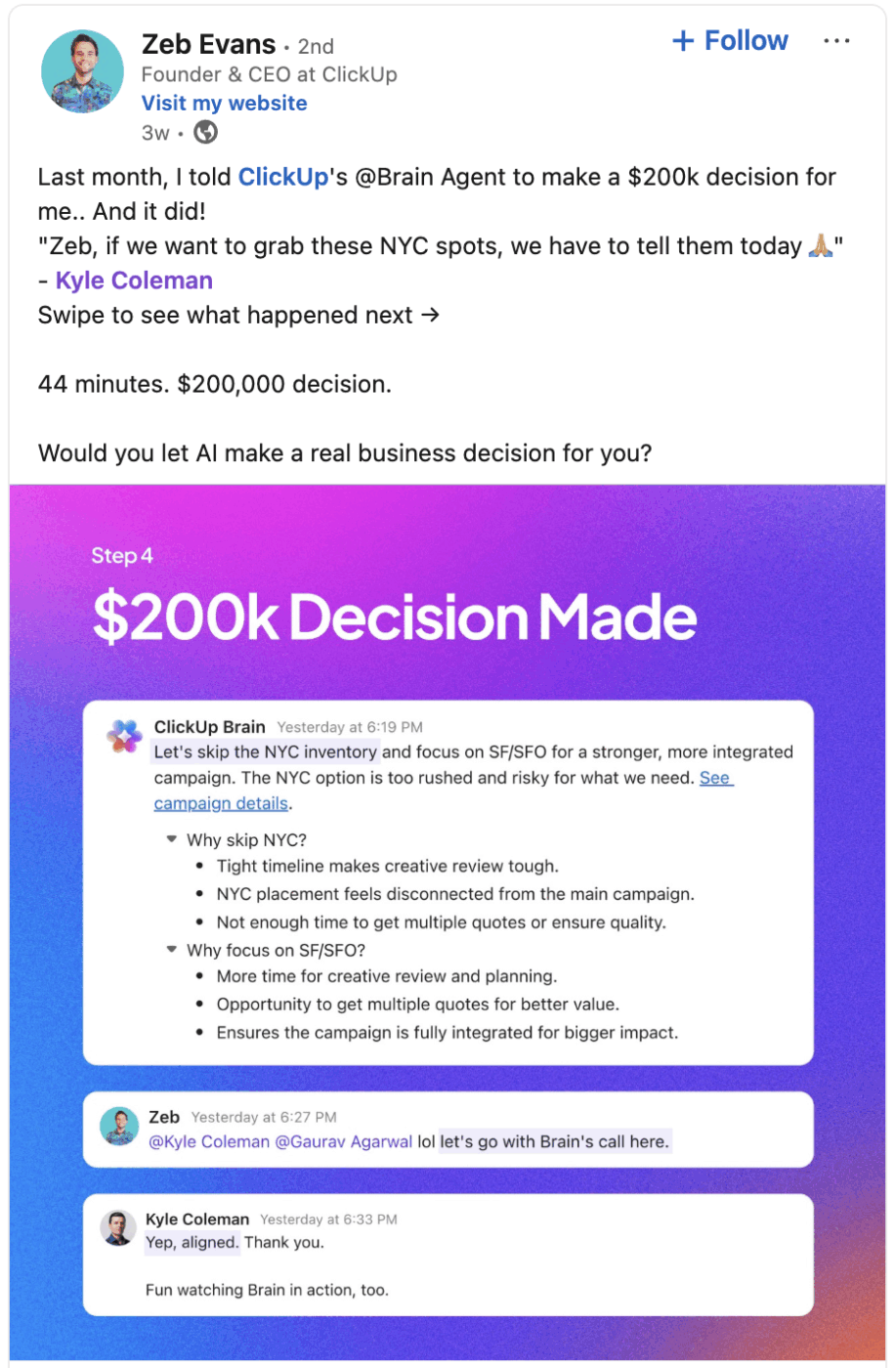
The trap it protects you from: Spending months solving the wrong problem because you never connected the dots between scattered signals.
ClickUp Automations: Make the trivial many handle themselves
The best way to apply Pareto isn’t working harder to ignore low-value tasks. It’s making those tasks disappear automatically.
ClickUp Automations and Agents move tasks, tag issues, send alerts, and escalate priorities when conditions are met. Set a rule: “When a campaign task is overdue → flag as high priority + ping the team.” Now bottlenecks surface instead of hiding in someone’s inbox.
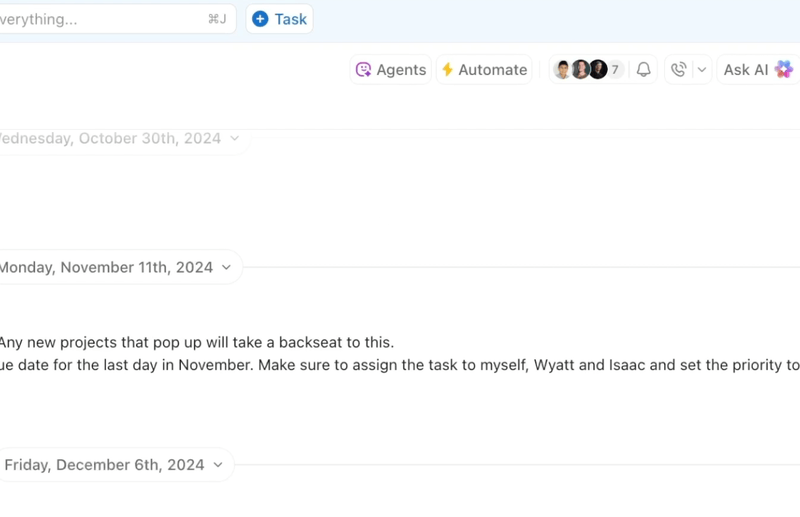
ClickUp Dashboards: See the skew, act on the skew
You can’t manage what you can’t see, and most teams are flying blind. They think they know where effort goes, but thinking isn’t data.
ClickUp Dashboards give you a visual X-ray of reality: which projects ate the most time, which clients deliver the bulk of revenue, which tasks advanced a goal versus which ones just churned hours.
The 80/20 split stops being abstract and becomes undeniable. And once you see it, you can’t unsee it.
Common Mistakes to Avoid
The 80/20 rule is like espresso: concentrated, powerful, and best in small doses.
Handle it incorrectly, and you’ll end up jittery and unfocused. Here are the classic blunders and what they look like in the wild.
1. Treating 80/20 as rigid math
The pattern doesn’t care about perfect fractions. Sometimes it’s 70/30, other times it’s 95/5, and occasionally the skew is even more extreme.
Research found that defects in software cluster extremely unevenly; just 1% of bugs caused half of all crashes (Hatton, 1997). Try forcing that into the tidy “80/20” label and you’ll miss the point entirely.
The blunder occurs when you get precious about the ratio.
2. Confusing correlation with causation
Just because 20% of customers bring 80% of revenue doesn’t mean those customers are inherently superior.
Maybe they just hit the market at the right time. Maybe they were early adopters chasing novelty, and now they’re one competitor away from churning.
Picture a SaaS company that goes all-in on its top five enterprise clients: the ones that generate most of the revenue.
- Sales shifts entirely to account management
- Product roadmap bends to their feature requests
- Marketing budget flows toward case studies with their logos
Then one of those clients gets acquired, two consolidate vendors, and suddenly 60% of revenue is gone. The company didn’t diversify because it mistook correlation (these clients pay a lot) for causation (these clients will always pay a lot). That’s putting all your eggs in five baskets and praying none of them break.
3. Ignoring slow-burn investments
“Compounding” is the “OG hero” in the finance world.
It is important, and everyone knows. It is the silent, productive worker who doesn’t make too much noise, but is ultimately what contributes to margins in the long run.
Innovation research shows that boring, incremental work, bug fixes, documentation, and technical debt cleanup often fuel the big leaps later (Pavitt, 1990).
Blockbuster is the textbook case. In the early 2000s, they focused on their “vital few”: DVD rentals from physical stores.
That’s where 100% of revenue lived, so that’s where resources went. Streaming? Trivial. Mail-order DVDs? Noise. By the time Netflix became undeniable, Blockbuster’s entire model was obsolete. They optimized themselves into irrelevance because they confused current revenue drivers with future ones. The vital 20% today isn’t always the vital 20% tomorrow.

4. Using Pareto as a hall pass for laziness
“Kill 80% of tasks” is not the same as “do nothing.”
If we chop down the entire tree because one branch looks sick, then wonder why nothing grows back, we miss the point of it. The vital few still need roots, water, and sunlight.
Pareto helps you cut the dead branches, not kill the whole tree.
5. Forgetting the 20% moves
Your top 20% doesn’t stay top forever.
- The whale account that once paid the bills can turn into a churn risk
- The marketing channel that crushed it last quarter might flatline the next quarter
- The product feature that drove adoption last year might be table stakes now
Teece et al. (1997) call this dynamic capabilities: the ability to sense, seize, and reconfigure as conditions change.
In plain English: you need to keep scanning and shifting, or you’ll optimize yourself into obsolescence.
Benefits of Applying the Pareto Principle
When applied consistently, the 80/20 rule changes how you think about work altogether.
Here’s how:
- You stop agonizing over decisions that don’t matter. After identifying your vital 20%, you know exactly where to focus. Everything else can wait. The decision fatigue just… evaporated
- You stop feeling guilty about what you’re not doing. That newsletter we poured six months into? Killing it didn’t feel like failure—it felt like relief. Once you accept that not everything deserves equal attention, the guilt of “not doing it all” disappears. Psychologists call this “perceived control,” and it’s directly linked to lower stress levels. Pareto restores that control
- Your results start compounding. This is the part people miss. Focusing on the high-value few doesn’t just give you quick wins—it builds momentum. Like compound interest, a small but consistent focus on the vital 20% creates outsized long-term gains. The newsletter budget we redirected to performance ads? It didn’t just work better, it got better every month as we refined what worked
- You stop arguing about priorities. Research on goal clarity shows employees are more engaged when they understand priorities (Locke & Latham, 2002). The 80/20 lens doesn’t just clarify, it ends the argument
- You gain the bandwidth to adapt. Blockbuster couldn’t pivot to streaming because they were too busy optimizing DVD rental stores. When you trim low-value activities, you free up resources for innovation, crisis response, and strategic shifts
Comparisons With Other Productivity Frameworks
The Pareto Principle doesn’t really play nice with every productivity fad.
Here’s where it stands apart, and why that matters.
Pareto vs. Eisenhower Matrix: Important ≠ Impactful
The Eisenhower Matrix wants you to separate “urgent” from “important.” Fine. That’s a useful first filter for cleaning your inbox or deciding if a meeting can wait. But here’s the problem: urgency doesn’t equal impact, and neither does importance.
Imagine you’ve got five “important, not urgent” tasks sitting in that coveted top-left quadrant. Eisenhower says they all deserve your focus. Pareto asks the sharper question: Which of those five will actually move the needle disproportionately? Maybe two of them matter. The other three? They’re “important” the way flossing is important—technically true, but not what separates winners from losers.
Eisenhower helps you avoid being busy. That’s table stakes. Pareto forces you to get consequential. There’s a reason executives who swear by the Eisenhower Matrix still feel overwhelmed, because they’re doing all the “important” work without asking which important work actually compounds.
Pareto vs. Principle of Least Effort: Lazy ≠ Ruthless
Zipf’s Principle of Least Effort says humans are lazy by nature; we’ll pick the easy path every time. True enough. And productivity gurus love to dress this up as wisdom: “Work smarter, not harder!” “Automate everything!” “Find the path of least resistance!”
But here’s the trap: the Principle of Least Effort doesn’t distinguish between efficient and coasting. It’s why people spend two hours automating a five-minute task, or why teams “optimize” email subject lines instead of fixing the product that’s hemorrhaging customers.
Pareto demands ruthless prioritization. It tells you to do less of the wrong work, even when that means tackling hard problems. Least Effort risks letting you feel productive while accomplishing nothing.
Pareto channels effort into leverage, even when leverage is hard. Sometimes the vital 20% is the work you’ve been avoiding because it’s uncomfortable, not because it’s inefficient.
Pareto vs. Eat the Frog: Hard ≠ High-Leverage
“Eat the frog” tells you to tackle the hardest, ugliest task first. Sounds heroic. Feels like discipline. And sometimes it’s exactly right.
I’ve watched people spend their best morning hours wrestling with a gnarly technical problem or a difficult conversation, “eating the frog,” while the task that would actually unlock the next three months of progress sits untouched.
Pareto doesn’t care how ugly the frog looks. It asks: If you eat this frog, does it matter?
Sometimes the hardest task is part of the vital 20%, and then yes, eat it first. Other times, it’s just pain dressed up as productivity theater. Let that frog sit in the corner and focus on the work that compounds.
The difference is, Eat the Frog optimizes for effort. Pareto optimizes for impact. And in a world where everyone’s working harder, impact is the only edge left.
The bottom line
Most productivity frameworks give you permission to feel organized. Pareto gives you permission to be effective. The former is about systems; the latter is about results. And when you’re choosing between the two, results win every time.
Criticisms and Limitations of the 80/20 Rule
The 80/20 rule is seductive, but misapplied; it can do as much harm as good.
The critics aren’t wrong, they’re just incomplete. Here’s where people get burned, what the research actually shows, and how to use Pareto wisely anyway.
1. Oversimplification: When uniformity beats asymmetry
Not every system bends to Pareto’s curve.
In highly standardized environments, think assembly lines, air traffic control, or hospital surgical protocols, output is often evenly distributed by design.
Researchers in operations management (Skinner, 1974) have shown that overemphasizing “vital few” efficiencies in manufacturing can sometimes introduce new bottlenecks elsewhere. Optimize one workstation, and the constraint suddenly shifts downstream.
Here’s a real example: Toyota’s production system famously doesn’t use Pareto thinking for quality control. Instead, they stop the entire line when any defect appears, even minor ones. Why? Because in tightly coupled systems, the “trivial many” defects compound into catastrophic failures. A loose bolt, seemingly a trivial 80% issue, can cause a recall that costs millions.
The wise use: Don’t force Pareto onto processes designed for uniformity. In systems where variance is the enemy, treating everything equally isn’t inefficiency; it’s insurance. Save Pareto for creative work, strategy, and resource allocation, where imbalance is natural and leverage exists.
2. Survivorship bias: The 96% nobody talks about
The business press loves to highlight companies where a few bets drove massive gains. Amazon’s AWS. Apple’s iPhone. Netflix’s streaming pivot. Sounds like Pareto magic, right?
The danger is thinking you can pick winners ex ante. Venture capitalists know this intimately: they need the entire portfolio because even professional investors with insider access can’t reliably identify which shares will rise.
Y Combinator funds hundreds of startups, knowing that one or two will generate the majority of the returns. That’s Pareto humility.
The wise use: Use Pareto to guide focus after the signal emerges, not before. In early-stage investing, product development, or content creation, you need portfolio thinking to survive long enough to discover your vital few. Once you see what’s working, that’s when you double down. The trick is knowing when you’re in the discovery phase (diversify) versus the exploitation phase (concentrate).
3. Neglect of long-tail value: When the “trivial many” become the platform
The “trivial many” sometimes hold future gold.
Niche users may not boost revenue today, but they surface innovation pathways that redefine the business tomorrow.
Case in point: Twitter’s early power users were a tiny minority—probably less than 1% of the user base. They didn’t drive significant revenue or mainstream adoption. By pure Pareto logic, they were noise. However, these users invented @mentions, hashtags, and retweets—features that became Twitter’s backbone and eventually shaped how billions of people communicate online (Honeycutt & Herring, 2009).
If Twitter’s leadership had ruthlessly applied 80/20 thinking in 2007, cutting features and support for “trivial” power users to focus only on mainstream growth, those innovations would’ve died in the weeds. Instead, the company had enough slack to let the long tail experiment, and the experiments became the product.
The wise use: Pareto helps you optimize the present, but don’t let it starve the future. Reserve 10-20% of resources – budget, attention, headcount – for exploration in the long tail. Google’s famous “20% time” wasn’t charity; it was insurance against optimizing themselves into obsolescence. The vital few of today often emerge from the trivial many of yesterday, but only if they survive long enough to prove it.
4. Misuse as dogma: When focus becomes starvation
When you wield Pareto like a machete, cutting 80% of initiatives, staff, or budget in one brutal round, they confuse focus with starvation.
Research on organizational resilience (Lengnick-Hall & Beck, 2005) indicates that firms require slack resources to effectively adapt to shocks. Cut too deeply in the name of efficiency, and you don’t get a lean organization – you get a brittle one.
Consider General Electric under Jack Welch. His “rank and yank” system, firing the bottom 10% of performers annually, was Pareto thinking taken to an extreme. It worked brilliantly in stable, predictable markets. But when the 2008 financial crisis hit, GE had cut so much slack that it nearly collapsed. The company had optimized for efficiency but sacrificed the adaptability needed to survive volatility (Groysberg et al., 2015).
The wise use: Apply Pareto with a margin of safety. Don’t cut to the bone; cut to health. Keep enough slack – redundant systems, exploratory projects, “inefficient” relationships, to absorb shocks and adapt when the environment shifts. Think of it as insurance: it looks wasteful right up until you need it.
The bottom line: Nuance over dogma
The 80/20 rule isn’t broken – it’s blunt. Used naively, it can distort strategy, starve innovation, or lull leaders into false certainty. Used wisely, it sharpens attention without cutting corners.
The trick isn’t throwing Pareto out. It’s applying it with nuance: knowing when to concentrate (exploitation) and when to diversify (exploration). Recognizing when systems need uniformity, not optimization. Reserving slack for the long tail that might become tomorrow’s platform. Building in margins of safety so focus doesn’t become fragile.
And most importantly, being willing to revisit the “vital few” every quarter—before they quietly become the “obsolete many” while you’re still optimizing for last year’s game.
Pareto is a scalpel. Use it like one: precisely, carefully, and only when it’s the right tool for the job.
The Future of the 80/20 Rule
If Pareto’s insight was born in the gardens of 19th-century Italy, its future lives in the servers of 21st-century data centers.
The rise of AI has made Pareto measurable in ways Pareto himself could never have imagined. Machine learning can instantly pinpoint which 20% of actions, users, or channels drive outsized results.
The principle is also shaping global debates.
Today, the top 10% of earners capture more than half of worldwide income—a stark reminder that imbalance isn’t just a productivity heuristic but a political and economic challenge. When wealth concentrates, societies face a choice: accept the skew as natural, or intervene to redistribute.
Pareto doesn’t answer that question, but it frames it.
Meanwhile, entire industries now run on Pareto logic. SaaS platforms hunt for the bugs that cause the most crashes. Logistics networks optimize the routes that move the most freight. Customer-success teams flag the accounts most likely to churn. The pattern is everywhere.
The 80/20 rule isn’t just a mental model anymore. It’s becoming infrastructure. The imbalance Pareto spotted in Italian gardens is now hard-coded into the tools we use every day.
Pareto: Your Path to Your Real Results
Forget tidy math. Most of what we do is noise. A handful of actions drive nearly everything that matters.
Pareto is about doing less of what doesn’t matter so you can do more of what does.
It’s permission to ignore the guilt of leaving things undone, to focus obsessively on the few things that compound.
Remember, the imbalance is the cheat code. The world rewards concentrated effort on the vital few far more than it rewards distributed effort on everything. Always has. Always will.
So the next time someone side-eyes you for ordering the same dish every Sunday, the one you’ve ordered fifty times before, the one that always hits, don’t apologize.
You’re simply allocating calories with Pareto-level efficiency. And while they’re still scanning the menu, paralyzed by choice, you’ll already be halfway through the meal that matters.
Frequently Asked Questions
The 80/20 rule says that a small number of inputs (roughly 20%) often account for the majority of outputs (roughly 80%)
Track where your time goes, identify the handful of tasks that drive the most results, and prioritize those. Tools like ClickUp Priority Levels make it easy to elevate the vital 20%.
No—it’s a heuristic, not a law. Sometimes the split is 70/30, 90/10, or more balanced. The insight is that outcomes are usually skewed, not evenly distributed.
AI can analyze large data sets to spot recurring blockers, high-performing channels, or high-value clients faster than humans. ClickUp Brain and predictive dashboards bring that analysis into your daily workflow.

